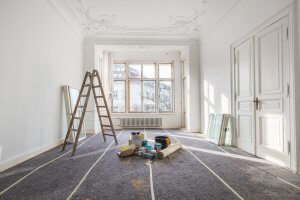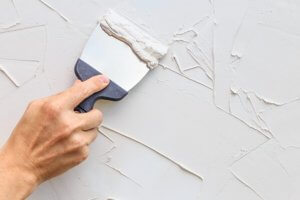How to Plaster Your Walls in 10 Easy Steps

Plaster is a thick paste, which you can apply to walls to make them flat and even. As a result, plaster allows you to get a more professional finish when it comes to painting your walls.
Plaster is also ideal for repairing cracks, holes, and other irregularities that often appear over time. The best thing is, you don’t need to be an expert to use plaster properly. In fact, you can apply plaster to your walls in just a few easy steps. Want to learn how? We’ll tell you everything you need to know in this article.
How to plaster your walls in 10 easy steps
Plaster is a great way to give your walls an elegant and stylish look. This material is perfectly designed to give walls a professional finish and makes applying paint easier. But how do you actually use plaster?
While it’s usually best to hire a professional for this kind of work, anyone can plaster their walls once they know how to do it. So, for those who are interested in learning a new skill, we’re going to give you some advice on how to plaster your walls.
Before you get started…
To prevent your walls getting damaged, experts advise treating them with PVA at least 24 hours before applying the plaster. This will protect them against humidity, and ensure the plaster dries evenly.

A step-by-step-guide to plastering your walls
- First, clean your chosen surface thoroughly. This step is crucial. If there is any dust or debris on the wall, the plaster won’t stick to it properly, and this can potentially spoil the overall finish. Next, sand the wall, then scrub it down with a stiff-bristled brush.
- If there are any traces of old paint, try to remove them with a trowel or scraper. Then follow the instructions in step one to ensure the wall is smooth and clean.
- Take a bonding liquid, and pour a small amount into a paint tray. Then, use a roller to apply it to the walls. Wait at least 15 minutes for the liquid to dry.
- Next, put the plaster in a plastic bucket and follow the manufacturer’s instructions to prepare the mixture. Mix well until you have the desired texture and consistency.
- Once your mixture is ready, use a steel pallet knife or trowel to apply it to the wall, working both vertically and horizontally. You’ll need to do 3 or 4 coats, making sure the first layer is completely smooth before going on to apply the next.
- Your plaster should be approximately 3/8″ thick.
- Once you’ve finished applying the plaster, leave it to set for a minimum 24 hours (although this may vary). Once dry, take a hose and rinse your wall with water. This will ensure a better overall finish.
- Once the wall is fully dry, use 150-grit sandpaper to smooth your wall and remove any irregularities.
- Clean the surface again and, if you need to, apply another coat of plaster. Make sure not to make the plaster too thick, as this will spoil the overall look.
- Finally, clean away any remaining residue, and paint the wall with a small roller. Apply one or two coats of paint for the perfect finish.
Maintaining plaster walls
Now that you’ve finished plastering your walls, you need to know how to maintain them properly. This will help ensure the plaster stays in good condition for years to come. Caring for plaster walls is actually really simple, and you won’t need any special cleaning products. All you’ll need is a spray bottle, water, and a soft cloth.
Clean your walls as soon as you notice any dirt. If you leave the dirt too long, it can stain the plaster. In some cases, you can use light, pH-neutral soap to remove tough stains.
Types of plaster on the market

There are several different types of plaster on the market today. However, generally speaking, you can classify them into three categories.
- Traditional: these plasters are made from materials that have been used since the 18th Century, such as gypsum, marble and calcium hydroxide.
- Synthetic: these are made from a mixture of different chemical formulas. The mixture is based on a patented formula and is sold pre-mixed. Since the 1950s, EIFS (Exterior insulation finishing system) has been one of the most popular synthetic plasters in the US.
- Modern: this includes plasters such as plastic stucco. They contain synthetic resins, normally made from acrylic. They are used as outer cladding, replacing paint entirely, and are much easier to apply than traditional plasters.
So, now you know how to plaster your walls. Follow our advice, and you’ll be plastering like a pro in no time. But remember, if you don’t have the time or the patience to plaster your walls yourself, you can always hire a professional to do it for you.
Plaster is a thick paste, which you can apply to walls to make them flat and even. As a result, plaster allows you to get a more professional finish when it comes to painting your walls.
Plaster is also ideal for repairing cracks, holes, and other irregularities that often appear over time. The best thing is, you don’t need to be an expert to use plaster properly. In fact, you can apply plaster to your walls in just a few easy steps. Want to learn how? We’ll tell you everything you need to know in this article.
How to plaster your walls in 10 easy steps
Plaster is a great way to give your walls an elegant and stylish look. This material is perfectly designed to give walls a professional finish and makes applying paint easier. But how do you actually use plaster?
While it’s usually best to hire a professional for this kind of work, anyone can plaster their walls once they know how to do it. So, for those who are interested in learning a new skill, we’re going to give you some advice on how to plaster your walls.
Before you get started…
To prevent your walls getting damaged, experts advise treating them with PVA at least 24 hours before applying the plaster. This will protect them against humidity, and ensure the plaster dries evenly.

A step-by-step-guide to plastering your walls
- First, clean your chosen surface thoroughly. This step is crucial. If there is any dust or debris on the wall, the plaster won’t stick to it properly, and this can potentially spoil the overall finish. Next, sand the wall, then scrub it down with a stiff-bristled brush.
- If there are any traces of old paint, try to remove them with a trowel or scraper. Then follow the instructions in step one to ensure the wall is smooth and clean.
- Take a bonding liquid, and pour a small amount into a paint tray. Then, use a roller to apply it to the walls. Wait at least 15 minutes for the liquid to dry.
- Next, put the plaster in a plastic bucket and follow the manufacturer’s instructions to prepare the mixture. Mix well until you have the desired texture and consistency.
- Once your mixture is ready, use a steel pallet knife or trowel to apply it to the wall, working both vertically and horizontally. You’ll need to do 3 or 4 coats, making sure the first layer is completely smooth before going on to apply the next.
- Your plaster should be approximately 3/8″ thick.
- Once you’ve finished applying the plaster, leave it to set for a minimum 24 hours (although this may vary). Once dry, take a hose and rinse your wall with water. This will ensure a better overall finish.
- Once the wall is fully dry, use 150-grit sandpaper to smooth your wall and remove any irregularities.
- Clean the surface again and, if you need to, apply another coat of plaster. Make sure not to make the plaster too thick, as this will spoil the overall look.
- Finally, clean away any remaining residue, and paint the wall with a small roller. Apply one or two coats of paint for the perfect finish.
Maintaining plaster walls
Now that you’ve finished plastering your walls, you need to know how to maintain them properly. This will help ensure the plaster stays in good condition for years to come. Caring for plaster walls is actually really simple, and you won’t need any special cleaning products. All you’ll need is a spray bottle, water, and a soft cloth.
Clean your walls as soon as you notice any dirt. If you leave the dirt too long, it can stain the plaster. In some cases, you can use light, pH-neutral soap to remove tough stains.
Types of plaster on the market

There are several different types of plaster on the market today. However, generally speaking, you can classify them into three categories.
- Traditional: these plasters are made from materials that have been used since the 18th Century, such as gypsum, marble and calcium hydroxide.
- Synthetic: these are made from a mixture of different chemical formulas. The mixture is based on a patented formula and is sold pre-mixed. Since the 1950s, EIFS (Exterior insulation finishing system) has been one of the most popular synthetic plasters in the US.
- Modern: this includes plasters such as plastic stucco. They contain synthetic resins, normally made from acrylic. They are used as outer cladding, replacing paint entirely, and are much easier to apply than traditional plasters.
So, now you know how to plaster your walls. Follow our advice, and you’ll be plastering like a pro in no time. But remember, if you don’t have the time or the patience to plaster your walls yourself, you can always hire a professional to do it for you.







